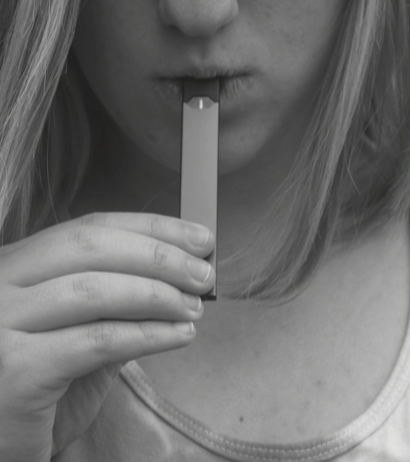Smoking up the community
As e-cigarretes begin to make their appearance in the media, so does the consequences and risks that follow

When a teen goes out in public, it’s no shock that they will see huge, colorful bulletin boards promoting e-cigarettes or find stores selling them within reach. Even in their own homes, students are blasted daily with social media and advertisements of vaping, as well as rumors of past weekend parties where kids “juul” or “vape”.
“There’s definitely been an increase in vaping societally,” Cristina Cortesi, substance abuse prevention coordinator, said. “There is a lot of misconception and people believe it’s a way to smoke without the negative effects but that’s a false belief.”
Emerging in the 2000s, e-cigarettes, or electronic nicotine delivery systems, are a variety of vaping devices that allow users to inhale an aerosol, typically containing nicotine and other additives. E-cigarettes vary in sizes of vaporizers, as well as the liquids and flavors of by the product. Common examples of e-cigarettes include vape and juul pens.
Over the years there has been a decrease in the use of smoking conventional cigarettes. However, in May 2016, the Food and Drug Administration (FDA) issued a statement saying that e-cigarettes should be regarded as a tobacco product. Despite this, e-cigarettes have officially replaced tobacco as the leading tobacco use product. According to Dean Steven Tucker, there has been an evident transition at Stevenson from tobacco products to more electronic devices.
Several factors that have been linked to the use of e-cigarettes are its social influence, social media, as well as its relative convenience compared to other substances.
“Students turn to products like these because they are able to mask the aroma of tobacco,” Tucker said. “E-cigarettes are also a more convenient size to slip in and out.”
However, despite the lack of research regarding long-term health risks associated with e-cigarettes, there exists a wide misconception on the actual consequences of vaping.
According to American Lung Association, nearly 500 brands and 7,700 flavors of e-cigarettes are on the market and none of them have been evaluated by the FDA. In addition, toxic chemicals like antifreeze and formaldehyde are present within e-cigarettes. E-cigarette users still run the same health risks as those who smoke a regular cigarette, namely lung and breathing problems.
“Most people vape because they think it’s a better substitute to smoking and it will do less harm to your body,” Anna Choi ’19 said. “I don’t think that any form of substance you take into your body is necessarily good for you.”
Not only does vaping have a negative impact on the body, but on the mental component as well. In many e-cigarette products, nicotine, an addictive substance, is common. This drug can be a gateway to the use of regular cigarettes, as well as stronger drugs.
“E-cigarettes can be a starting point that leads to tobacco products,” Choi said. “I think if people start vaping now, later on it might become a bigger influence to start smoking.”
Due to miseducation, a majority of high school students are unaware of the true effects of e-cigarettes. According to the recent Illinois Youth Survey, students have a gross over percentage of people who are using e-cigarettes as well as a under percentage of the risk.
“When people don’t accurately perceive the risk and they over perceive the people doing it, we will see an increase in the amount of use,” Cortesi said.
To prevent the use of vaping within Stevenson, the use of e-cigarettes in school has the same punishment if caught with tobacco products. Consequences of using e-cigarettes can range from detentions, 1-5 alternative day assignments, in-school suspensions.
Not only can students face consequences with the school, but with the police department as well. Since e-cigarettes are considered an illegal tobacco product to minors, students can face a status offense, or an action that is only prohibited to a certain case of people.
According to police officer Rick Coakley, minors can face punishments as far as citations to go to court, due in part to their behavior, attitude and past contacts with e-cigarettes. In addition, police officers have the right to confiscate possessions, conduct searches of the person and their belongings and issue tickets.
In addition to Stevenson, Lincolnshire is enforcing more laws to prevent the use of e-cigarettes. In 2016, Lincolnshire passed an ordinance that prohibits the use of electronic delivery systems in public places. Furthermore, other states are also supportive of moving the legal age of of e-cigarettes to 21. Although not all of the dangers and risks of e-cigarettes are known, Cortesi hopes that Stevenson does their research to discover the true negative impact vaping can have on their lives.
“I would encourage students to look at the research and make educated and informed decisions rather than going with what they are seeing around them,” Cortesi said. “Just because it is legal, doesn’t make it safer.”

